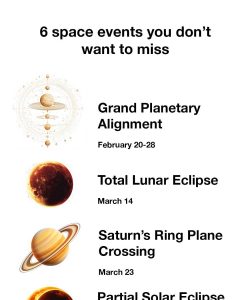The universe is an endless expanse filled with breathtaking phenomena that have fascinated humans for centuries. From the mysterious pull of gravity to the dazzling spectacle of meteor showers, these celestial events offer more than just visual beauty—they serve as reminders of our place in the cosmos. Stargazing is one of the oldest human traditions, shared across cultures and generations. As our technology has evolved, so too has our ability to understand and predict the movements of celestial bodies. The sky continues to tell us stories, and it invites us to look up and wonder. With several notable space events on the horizon, there’s never been a better time to turn your eyes to the heavens and experience the magic of the night sky.

One of the most anticipated astronomical events in the coming months is the grand planetary alignment, set to occur from February 20 to 28. A planetary alignment is when several planets appear in a straight line from our point of view on Earth. While planets are never perfectly aligned, they can appear closely clustered together in the sky. This time, Mars, Jupiter, Saturn, and Venus will take center stage, offering a spectacular view that both casual skywatchers and amateur astronomers can enjoy. You won’t need a telescope to witness this celestial parade—just a clear sky and an unobstructed view of the horizon. The alignment offers not only a mesmerizing sight but also a chance to consider the gravitational forces at work in our solar system. When these planetary giants line up, they serve as a stunning example of orbital mechanics and cosmic timing.
Shortly after the alignment, on March 14, a total lunar eclipse will grace the skies. Often referred to as a “blood moon,” this event occurs when the Earth passes directly between the sun and the moon, casting a shadow that covers the moon entirely. Because of how Earth’s atmosphere scatters light, the moon takes on a reddish hue, turning into a dramatic and ghostly sphere in the night sky. This event is a favorite among photographers and stargazers alike due to its haunting beauty and symbolic significance. Unlike solar eclipses, lunar eclipses are safe to view with the naked eye, making them accessible to anyone with a clear view. The upcoming eclipse will be visible from multiple continents, allowing millions of people to participate in this shared celestial experience.
Later in the month, on March 23, Saturn will undergo a ring plane crossing. This rare phenomenon takes place approximately every 15 years when Saturn’s rings appear edge-on from Earth, making them nearly invisible. While the planet still retains its golden hue, its iconic rings seem to vanish, offering a very different perspective of the gas giant. This fleeting moment allows astronomers to observe Saturn’s moons and the shadows they cast in greater detail, helping scientists learn more about the planet’s complex system. For amateur astronomers, it’s an unusual sight that underscores the dynamic and ever-changing nature of the cosmos.
Then, on March 29, a partial solar eclipse will occur. Although it doesn’t completely block out the sun like a total solar eclipse, it’s still an impressive and dramatic sight. During this event, the moon passes between Earth and the sun, covering a portion of the solar disk and creating a crescent-like sun. Proper solar filters or eclipse glasses are essential for safe viewing. This eclipse will be visible from various regions around the world, making it a perfect opportunity for schools, astronomy clubs, and families to come together and learn about the science behind eclipses. It’s a great reminder of the delicate choreography between celestial bodies and how their movements create moments of awe on Earth.
One of the most enjoyable events for stargazers happens on April 22, when the Lyric meteor shower reaches its peak. This annual shower, caused by Earth passing through debris left behind by Comet Thatcher, is known for its bright and fast-moving meteors. Under ideal conditions, viewers can expect to see up to 20 meteors per hour streaking across the sky. The Lyric meteor shower is particularly favored by both novice and experienced skywatchers because of its consistency and potential to produce large, brilliant fireballs. The best time to watch is after midnight, away from city lights, when the sky is darkest and the meteors are most visible.
Just a few days later, on April 25, another rare treat awaits: a triple conjunction. This event occurs when three planets—this time, Mercury, Venus, and Jupiter—appear to be very close to one another in the night sky. While they’re still millions of miles apart in space, their orbits bring them into the same line of sight from Earth. Triple conjunctions are rare and brief, so catching a glimpse requires careful planning and a bit of luck with the weather. Observing these planets clustered together offers not just a visual feast but also a deeper appreciation of the orbital dance that governs our solar system. For those who enjoy astrophotography, this event presents a beautiful subject to capture and share.
Beyond their beauty, these six events highlight the ongoing importance of astronomy in our lives. Observing the sky helps us understand not just the universe, but also ourselves. It gives us perspective, reminding us that we are part of something much larger. Stargazing connects us to our ancestors, who relied on the stars for navigation, storytelling, and spiritual guidance. Today, it continues to inspire innovation, curiosity, and a sense of wonder. Whether you’re watching a meteor shower with friends, capturing the blood moon with your camera, or simply stepping outside to see a planet alignment, each event brings us closer to the mysteries of the universe.
In a fast-paced world filled with distractions, taking a moment to gaze at the stars can be both grounding and enlightening. These upcoming celestial events are free to experience and open to anyone with the time and curiosity to look up. They remind us of the order and chaos of the cosmos and the fleeting beauty that lies beyond our atmosphere. So grab a blanket, set up a lawn chair, and don’t forget your telescope or binoculars if you have them. These astronomical happenings are nature’s way of putting on a show, and all you have to do is watch.





